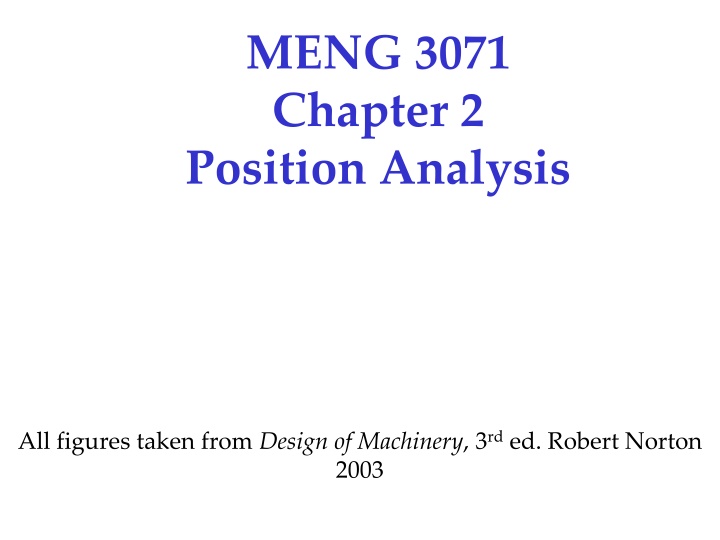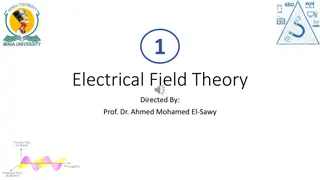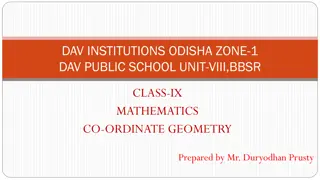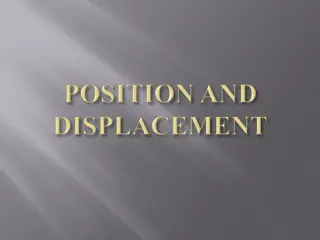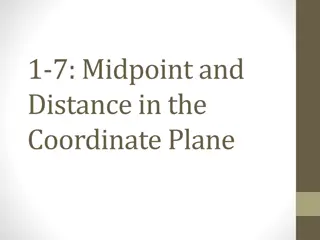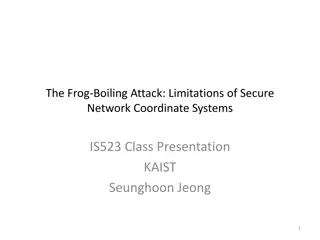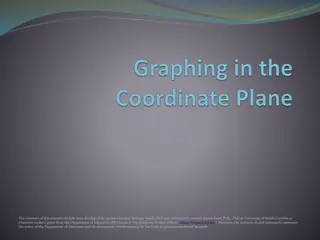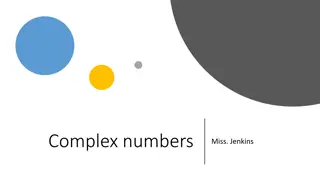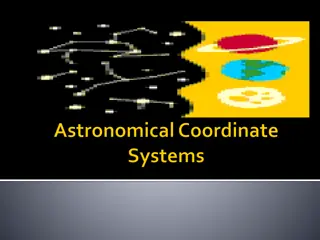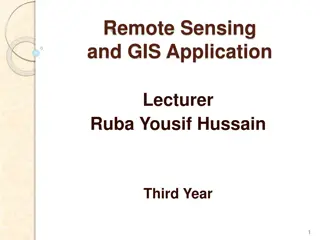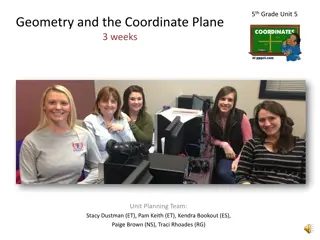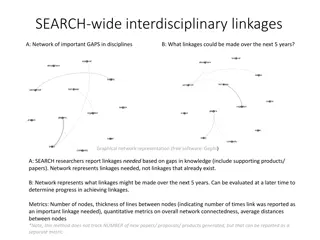Position Analysis of Linkages: Understanding Coordinate Systems and Complex Motion
Graphical and algebraic methods for position analysis of linkages in machinery design. Learn about coordinate systems, translation, rotation, complex motion, and analytical techniques to determine unknown angles. Understand the use of complex numbers as vectors in the analysis process.
Download Presentation

Please find below an Image/Link to download the presentation.
The content on the website is provided AS IS for your information and personal use only. It may not be sold, licensed, or shared on other websites without obtaining consent from the author.If you encounter any issues during the download, it is possible that the publisher has removed the file from their server.
You are allowed to download the files provided on this website for personal or commercial use, subject to the condition that they are used lawfully. All files are the property of their respective owners.
The content on the website is provided AS IS for your information and personal use only. It may not be sold, licensed, or shared on other websites without obtaining consent from the author.
E N D
Presentation Transcript
MENG 3071 Chapter 2 Position Analysis All figures taken from Design of Machinery, 3rd ed. Robert Norton 2003
Coordinate Systems Cartesian (Rx, Ry) Polar (RA, ) Converting between the two 2 2 = + = R R R cos R R A = x y R x A ( ) = sin R R arctan R y A y x Position Difference, Relative position Difference (one point, two times) relative (two points, same time) Y B RBA A RBA=RB-RA RA RB X
4.3 Translation, Rotation, and Complex motion Translation: keeps the same angle Rotation: one point does not move Complex motion: a combination of rotation and translation
Graphical Position Analysis of Linkages Given the length of the links (a,b,c,d), the ground position, and 2. Find 3 and 4 b B c b 3 A c a 4 2 d O2 O4
Graphical Linkage Analysis b Draw an arc of radius b, centered at A Draw an arc of radius c, centered at O4 The intersections are the two possible positions for the linkage, open and crossed c B1 b A 3 c a 4 d 2 O2 O4 B2
Algebraic Position Analysis Obtain coordinates of point A: = cos A a 2 x = sin A a 2 y Obtain coordinates of point B: ( ) ( ( ) 2 2 = + 2 b B A B A x x y y ) 2 2 = + 2 c B d B x y These are 2 equations in 2 unknowns: Bx and By See solution in textbook pages 171, 172.
Complex Numbers as Vectors We can plot complex numbers on the real- imaginary plane Euler identity e i =cos i sin Cartesian form: RAcos + i RAsin Polar form: RAei Multiplying by ei corresponds to rotating by Imaginary Real
Analytical Position Analysis Given: link lengths a,b,c and d, (the motor position) Find: the unknown angles and
Analytical Position Analysis Write the vector loop equation: + = 0 R R R R 2 3 4 1 (Positive from tail to tip) Substitute with complex vectors + be ae i i i i = 0 ce de 3 2 4 1 Take knowns on one side, unknowns on the other. Call the knowns Z i i i i = + = be ce ae de Z 3 4 2 1 Unknowns Knowns
Fourbar Linkage Analysis ae ce be = + = i i i i de Z = = 3 4 2 1 bs ct Z i i = = , s e t e Define: 3 4 s b t c Z Take conjugate to get a second equation: 1 i 1 s i = = = For the conjugate of s we have (only true for ei ) s e 3 e 3 So our second equation is b c = Z s t 1 Z Note: Z
Fourbar Linkage Analysis b c = bs ct Z = Z s t Use algebra to eliminate one of the unknowns b c = + bs Z ct = + Z s t Multiplying the two gives: c = + + + 2 2 b Z Z Z Z ct c t Multiplying by t and collecting terms gives: ( ) ( = + + + 2 2 2 0 Z ct Z Z c b t Zc Quadratic equation in t ) ( ) 2 + + 2 2 2 2 2 4 Z Z c b Z 2 Z c b c Z Z From the quadratic formula = t Z c + Z ct = s b
Fourbar Linkage Analysis ) c Z 2 ( ( ) + 2 Z ct + + 2 2 2 2 2 4 Z Z c b Z Z c b c Z Z = s = t b ( ) = + + + 2 2 2 In MATLAB, Zc=conj(Z) t=roots([Zc*c,Z*Zc+c^2-b^2,Z*c]) 4=angle(t), 3=angle(s) Two solutions relate to the open and crossed positions 0 Z ct Z Z c b t Zc B1 b A 3 c a 4 d 2 O2 O4 B2
MATLAB Change your current directory Type in your commands here or Use a text editor
>> a=2; b=3; c=4; d=5; >> th1=0; th2=60*pi/180; >> z=-a*exp(i*th2)+d*exp(i*th1) >> th4=angle(t)*180/pi th4 = B z = 4.0000 - 1.7321i 114.7975 -161.6240 b 3 >> zc=conj(z) A >> th3=angle(s)*180/pi zc = 4.0000 + 1.7321i c th3 = a >> t=roots([zc*c,z*zc+c^2-b^2,z*c]) 4 39.2750 -86.1015 2 d t = -0.4194 + 0.9078i -0.9490 - 0.3153i O2 O4 >> s=(z+c*t)/b s = 0.7741 + 0.6330i 0.0680 - 0.9977i
Animation on MATLAB % ******************************* % Animation of a four-bar linkage clear; close all; % Define parameters (link lengths) a = 1; b = 3; c = 4; d = 5; th1 = 0; % Now loop on the crank angle for th2 = 0:0.05:2*pi z = -a*exp(i*th2)+d*exp(i*th1); zc = conj(z); t = roots([zc*c,z*zc+c^2-b^2,z*c]); s = (z+c*t)/b; th3 = angle(s); pA = a*exp(i*th2); % Position of point A pB = pA+b*exp(i*max(th3)); % Be careful here! % We took max(th3) because that will give the 'open' position. % This may not work for all cases, so watch out! % Now plot and animate. Fix the axis limits to see the animation. plot([0 real(pA) real(pB) d 0],[0 imag(pA) imag(pB) 0 0],'linewidth',8); axis([-1.2*a 1.2*d -c c]);%axis off pause(0.01) end
Inverted Crank Slider linkage Given: link lengths a, c and d, (the motor position), and the angle between the slider and rod Find: the unknown angles and andlength b
Inverted Crank Slider linkage Write the vector loop equation R R = 0 R R 2 3 4 1 Substitute with complex vectors ce be ae i i i i = 0 de 3 2 4 1 Geometry keeps 3 = + 4 so ae ( ) i + i i = i 0 be ce de 2 4 4 1
Inverted Crank Slider ( ) i + i i = i 0 ae be ce de 2 4 4 1 Grouping knowns and unknowns ( ) + + = = = i i i i be ce and = ae e ( s de Z 4 4 2 1 i i = + Calling Gives Taking the conjugate to get the second equation s e cs t = 4 + ) bst Z bt c 1 1 + = = + t b ( ) s c Z b c s t Multiplying the two gives + 1 + + = 2 2 b bc t c Z Z t
Inverted Crank Slider The solution is a quadratic equation in b + 1 + + = 2 2 b bc t c Z Z t 1 t = + + b c + 2 2 0 b c t ZZ Which has a solution of ( ) ( ) ( ) 2 1 1 + + 2 2 4 c t t c c ZZ t t = b 2 b=roots([1 c*(t+1/t),c^2-Z*Zc]) Once b is known, s can be found using Z + = s bt c
Crank Slider Mechanism Given: link lengths a, b and c, (the motor position) Find: the unknown angle andlength d
4.8 Linkages of More than Four Bars Geared fivebar linkage vector loop equation + = 0 R R R R R 2 3 4 5 1 Complex vectors i i i + ae be ce 3 2 4 i = 0 de f 5 Separate unknowns and knowns ( 5= + ) (same eqn. as 4bar) i i i i = + + = be ce ae de f Z 3 5 4 2
Sixbar Linkages Watt s sixbar can be solved as 2 fourbar linkages R1R2R3R4, then R5R6R7R8 R4 and R5 have a constant angle between them
Sixbar Linkages Stephenson s sixbar can sometimes be solved as a fourbar and then a fivebar linkage R1R2R3R4, then R4R5R6R7R8 R3 and R5 have a constant angle between them If motor is at O6 you have to solve eqns. simultaneously
Position of any Point on a Linkage Once the unknown angles have been found it is easy to find any position on the linkage For point S Rs=sei( 2+ 2) For point P RP=aei 2+pei ( 3+ 3) For point U RU=d+uei ( 4+ 4)
Example Given: a,c,d, 2 Find: position of point P (coupler curve) ae d be + In MATLAB: z = a*exp(i*th2)-d; b = abs(z); th3 = angle(z); i i = = be ae d z i = i 3 2 3 2 ce i = i Pr ae 3 2 b a c d 11 P
MATLAB m-file clear; close all; a = 2.4; c = 13.4; d = 8; cupcur = []; for th2 = 0:0.1:2*pi z = a*exp(i*th2)-d; b = abs(z); th3 = angle(z); rp = a*exp(i*th2)-c*exp(i*th3); cupcur = [cupcur rp]; X = [0 real(a*exp(i*th2)) real(rp)]; Y = [0 imag(a*exp(i*th2)) imag(rp)]; plot(X,Y,'.-'); axis equal; axis([-5 20 -5 5]); grid; hold on; plot(real(cupcur),imag(cupcur),'.r');hold off;axis off pause(0.1) end Mt1f13.avi b a c d 11 P
Transmission Angle Extreme value of transmission angle when links 1 and 2 are aligned ( ) bc 2 ( ) 2 + bc 2 + 2 2 b c d a 2 + 2 2 b c d a = arccos 1 = arccos 2 Extended Overlapped
Toggle Position Caused by the colinearity of links 3 and 4. + = toggle 2 2 ad 2 2 2 2 a d b c bc 1 cos 0 2 ad toggle For a non-Grashof linkage, only one of the values between the () will be between 1 and 1 Overlapped 2 Extended 2
